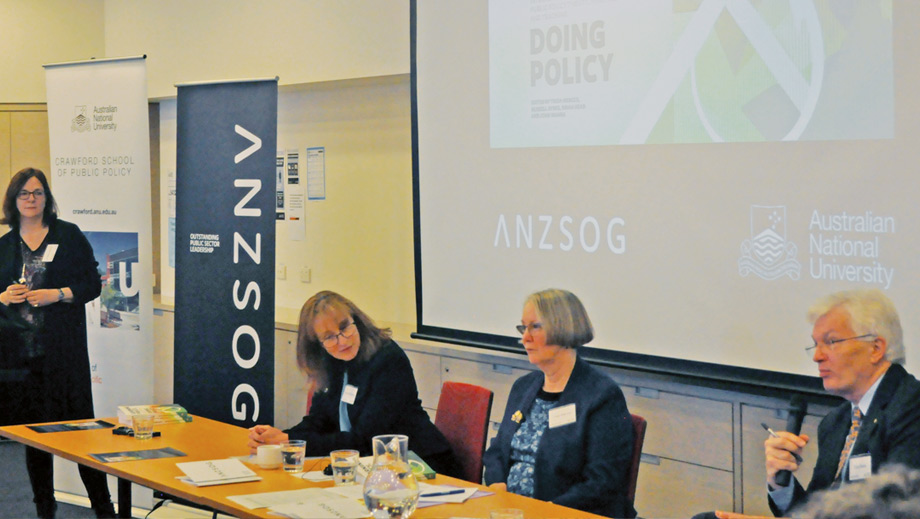Book Launch – Learning Policy, Doing Policy
On 16 June, Professor Ariadne Vromen chaired a breakfast launch of the new ANU Press ANZSOG series publication Learning Policy, Doing Policy. This is the latest in what is a long series of publications from Australia and New Zealand School of Government (ANZSOG), which is rapidly approaching its 20th year of education and research. The book was officially launched by Professor Glyn Davis, chair of the ANZSOG Research Committee and Chief Executive Officer of the Paul Ramsay Foundation. Professor Davis, who is a public policy specialist, commended the book as a rich resource: ‘Learning Policy, Doing Policy speaks to everyone engaged in policy work, from seasoned public servants to students and their teachers.’ Other speakers were editor Trish Mercer, Visiting Fellow in ANZSOG, who spoke to the genesis and purpose of the book, and Louise Gilding, Executive Group Manager of Housing ACT, who demonstrated how theory can provide a valuable tool for those engaged in ‘policy on the run’.
Download the book for free or purchase a copy: http://doi.org/10.22459/LPDP.2021
ANZSOG series founder John Wanna reflects on Learning Policy, Doing Policy
How do public servants (and policymakers more generally) think about the craft of policymaking and about how they do policy work in practice? How do they understand the various systems in which they operate, engage with new ideas or perspectives, negotiate the procedures that guide their decision-making and address the many challenges of their chosen profession?
Do policy practitioners learn through on-the-job training and experience, or do they work from theories and models of the policy processes in guiding policy development? Might some practitioners increasingly with tertiary education in the social sciences work from academic conceptualisations of how policy works or could work better?
This significant book analyses how Australian practitioners ‘learn’ policy work, and how they ‘perform’ the roles expected of them by governments. It explores different understandings of policy, different models and theoretical approaches and even differing values and cultures extant in those practising policy work, informing understandings of human nature. It also canvasses to what extent the roles and responsibilities of practitioners have changed as government has modernised, moving from bureaucratic administration to corporate management, through to contract management and network management.
The so-called ‘policy sciences’ were developed from the 1960s to improve policymaking and provide more normative or realistic accounts of the policy process. Writers explored decisionmaking norms and practices, including the values that were fundamental in serving the public interest. They debated what steps or stages should be undertaken in policy design, and whether or not policymakers had the requisite information and knowledge necessary to make informed decisions this created a new accessible literature on policy work that went around the world and informed both academic teaching of policy and practitioner behaviours. It also became a field of enormous controversy, with different advocates of preferred approaches.
So this ANZSOG study, published in March 2021, analyses the degree to which practitioners take theory into their practice, but also use practice to better inform them about models and theoretical approaches. It assesses how policy capacities develop and are improved by innovation, collaboration and the cross-fertilisation of ideas and approaches. The authors are a mixture of public administration scholars, prac-academics with feet in both camps, and practitioners with extensive experience in making policy more fit-for-purpose and appropriate to the circumstances as well as more in accordance with the public interest and more accountable through the democratic political system.
Policy theories and approaches are explanations of decisionmaking processes. There is no ‘one-size fits-all’ interpretation or approach, and many practitioners work from a compendium of alternative perspectives gained over many years of experience. The issue for them is knowing which approach or mixture of approaches works best in what circumstances. It’s a question of ‘horses for courses’, bearing in mind the constraints of time and resource, information sources, political realities, professional values, and analytical and evaluative research available. Many experienced practitioners pride themselves on being able to translate the lessons from policy studies into closer proximity to practice and the realpolitik policy world they find themselves inhabiting. These capabilities and skills greatly enhance their abilities to make better informed policies and better designed policy outcomes for the wider community. This book is essential for anyone interested in improving public policy design and augmenting the capacities of government.




